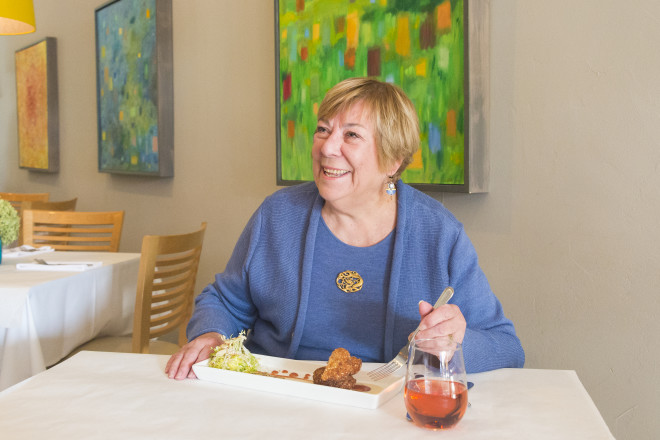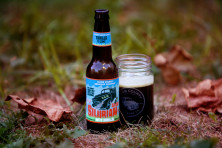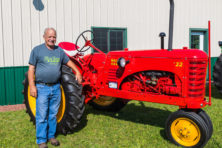Anything But Plain: Nielsen-Massey Vanilla
- Share
- Tweet
- Pin
- Share

Let’s imagine for a moment that it’s Door County Trivia Night and the Food and Wine Category has been chosen. The question reads: “What do Egg Harbor resident Cam Nielsen, the Spanish explorer Hernando Cortez, Queen Elizabeth, Thomas Jefferson and a 12-year-old freed slave have in common?” A turn of the card yields the answer: “They’ve all played a role in bringing us the world’s most popular flavor.” Extra credit goes to those who guess that that flavor is vanilla!
Cam Nielsen is the retired president and matriarch of the Nielsen-Massey company, one of the world’s largest and most respected producers of Madagascar Bourbon pure vanilla extract, vanilla paste, whole beans and other vanilla-based products.
Founded as Massey’s in 1907, the Chicago-based company manufactured aromas for cleaning chemicals. Cam’s father-in-law, Chatfield Nielsen, became involved in 1917 and steered the company toward the vanilla trade. “I guess he liked the smell of vanilla more than the smell of detergents!” Cam surmises.
Whatever the reason, it turned out to be a propitious move. The company is now one of the top three buyers of vanilla beans in the world and is often judged number one in quality.
Cam, a social worker by training, began working alongside her late husband, Chat Nielsen, Jr., in 1979.
“When you’re in a family business, you live and breathe it together. We did trade shows for many years and I learned a lot that way.”
In 1981, Nielsen-Massey expanded from wholesale supply to retail for home consumers thanks to a suggestion from Chuck Williams of Williams-Sonoma.
“He convinced us to give the retail market a try and featured us prominently in one of his catalogs.” Cam laughs at the memory. “The phone started ringing off the hook and we never looked back.”
They later added botanical pure flavor extracts such as almond, orange and lemon to their offerings.
Cam explains that when Chat took a leave of absence for bypass surgery, “we had a lot of decisions to make. He looked at me one day and said, ‘I think you could run this company.’” After his death in 1992, she did just that.
“When I look back, I’m so grateful to have married a man who believed women were smart and qualified. He became my mentor once we knew we would never grow old together; he taught me everything I know about vanilla. There were many competitors who believed Nielsen-Massey would be gone within a year of Chat’s death.”
With satisfaction, she states, “We proved them wrong.”
Under Cam’s direction, the company added new product lines and opened its first international manufacturing facility in the Netherlands. Cam lived in the Netherlands for more than a year to oversee the process.
Along with establishing a successful business, Nielsen-Massey has amassed a following of loyal customers. Sharon Peterson, chef/owner of 136 Restaurant and Wine Bar in downtown Sturgeon Bay, is one of them.
“I go through a gallon of Nielsen-Massey vanilla every two weeks,” she states. “I’ve tried other brands, but now it’s the only one I’ll use. It’s the best-tasting vanilla available.”
Peterson is a self-proclaimed “vanilla addict” and admits to adding vanilla to “just about everything.” (See sidebar for 136’s Baked Oatmeal with Orange Vanilla Crème and Rhubarb Sauce featuring Nielsen-Massey vanilla.)
Beth Nielsen, Cam’s daughter and Nielsen-Massey’s chief culinary officer, explains why the liberal use of vanilla makes sense. “Vanilla is Mother Nature’s MSG (monosodium glutamate). While it has its own great flavor, it really shines as a flavor enhancer and melder.”
She was asked recently in a radio interview to name one recipe she wouldn’t use vanilla in. She laughs, “It took me awhile to come up with an answer. I use it in everything – savory dishes, salad dressings, anything with a tomato base because it cuts acidity. I finally said ‘Eggs Benedict’ ’cuz I stick to the classic recipe for that!”
History of Vanilla – A Conqueror, a Queen, a Smuggler and a Slave
Although vanilla is sometimes described as “just plain,” that’s a misnomer. With between 250 and 300 distinct flavor compounds, pure vanilla has a depth and complexity mirrored by its history.
First grown in Mexico by the Totonaco Indians, vanilla made its way to Europe when Cortez conquered the Aztecs (who had earlier conquered the Totonacos) in 1520. Along with jewels and other riches, Cortez collected cacao and vanilla beans, ingredients necessary for a delectable drink called Chocolatl. For 80 years, vanilla was used solely for this delicacy. Fortunately for us, Queen Elizabeth had a sweet tooth and a clever apothecary, Hugh Morgan, who helped satisfy his liege’s cravings by using vanilla as a flavoring of its own.
The next advance in vanilla came nearly 200 years later when an unknown entrepreneur smuggled vanilla vines from Mexico, the only place they grew, to the Bourbon Islands, hoping to increase production. Unfortunately, he left behind the tiny Melipone bee needed for pollination. So, while the vines flowered, they produced few pods.
In 1836, a respected Belgian botanist, Charles Morren, discovered a way to fertilize the vanilla orchid without the bee, but his method was too laborious for commercial purposes. The access to vanilla we enjoy today is thanks to an adolescent slave boy named Edmond Albious who, in 1841, separated the male anther from the female stigma with a blade of grass or small stick and rubbed the pollen over the stigma with his thumb. His revolutionary procedure is still used today. (Legend has it that Albious died in poverty, uncompensated for the contribution he made to culinary history.) The last figure mentioned in our trivia question, Thomas Jefferson, is credited with bringing 200 vanilla beans to the United States from France in the late 1700s. His recipe for vanilla ice cream was recently rediscovered.
Vanilla Orchids, Pods and Beans
Most of the vanilla Nielsen-Massey purchases is from Madagascar, the largest of the Bourbon Islands. Vanilla production accounts for more than half of the island’s economy and is grown on family farms. A family of four can successfully farm about an acre of vanilla vines. Since each vanilla orchid opens for only a few hours, the farmers check their crops daily. If the flower is not pollinated during those few hours, no pod will grow. When vanilla pods are fully developed, farmers brand them with pins stuck into small pieces of cork in a pattern unique to each family. The brand stays with the bean through the curing process.
After the green pods are harvested, they are immersed in hot water. The farmer then begins a process of laying the beans in the sun to warm during the day and wrapping them in blankets or straw mats to sweat at night. This happens over and over again, with the entire curing process taking between three and six months. The cured beans are bundled into bunches of 60 to 100 and shipped to production facilities.
It is at this point that Nielsen-Massey really distinguishes itself. Cam explains that “most manufacturers use heat and pressure to extract flavoring from the beans. We use a cold process that’s much gentler on the flavor components and can take up to five weeks rather than days.”
Most of the world’s vanilla comes from five areas – Madagascar, Mexico, Indonesia, French Polynesia and Uganda. According to Cam, “Each region has its own distinct taste and characteristics depending on the soil. Mexican vanilla is a bit spicier. Madagascar beans produce the creamy, sweet flavor we love.”
Cam recently retired from her role as president of Nielsen-Massey and is pleased that all of her children – Craig, Beth and Matt – now run the company and represent the third generation of Nielsens to do so. Beth describes her mother’s leadership as both “inspiring and empowering” and notes that Cam remains active on the Nielsen-Massey board of directors and with the Nielsen-Massey Foundation, an entity created to assist with education and leadership in the culinary arts and aid in the development of sustainable environmental practices.
Cam speaks from experience in saying “a family business is like having another child. It is always part of your life; it’s on your mind 24/7.” When asked about the fringe benefits of a life in the vanilla trade, she can name many.
“Our children certainly grew up knowing more about vanilla than their peers! They also learned that there’s a line of continuity that passes from generation to generation even amidst the ups and downs.”
And then there are the people she’s met through Nielsen-Massey.
“I’ve been privileged to know so many wonderful chefs and customers and people who dream of creating their own gourmet food companies.”
The final benefit? “So much great ice cream.”
Nielsen-Massey products are available in Door County at Cornucopia Kitchen Shop, Sturgeon Bay; Main Street Market, Egg Harbor; and The Main Course, Fish Creek.
Baked Oatmeal, featuring Nielsen-Massey Vanilla
Recipes courtesy of 136 Restaurant and Wine Bar
1/2 cup canola oil
1/2 cup walnut oil
1 1/4 cup sugar
4 eggs
2 Tbsp cinnamon
1 Tbsp Nielsen-Massey vanilla
1 Tbsp Meyers rum
1 Tbsp Grand Marnier
1 1/2 tsp salt
1 cup milk
1 1/4 cup cream
6 cups oatmeal (not quick cook or instant)
Combine all ingredients in mixer with paddle attachment and mix thoroughly on low speed. Pour into greased 9” x 13” glass pan. Cover with plastic wrap and refrigerate overnight. Bake uncovered at 350 degrees for 30 minutes. Serve with Orange Vanilla Crème and Rhubarb Sauce, if desired. Serves 12.
Orange Vanilla Crème
1 cup sour cream
1/2 Tbsp Nielsen-Massey vanilla bean paste
1 Tbsp Door County maple syrup
1/2 Tbsp Grand Marnier
1/2 Tbsp orange zest
1/2 Tbsp cream
2 ½ Tbsp sugar
Combine all ingredients in blender for 15 to 30 seconds.
Rhubarb Sauce
4 cups sliced rhubarb
1/3 cup Grand Marnier
1/2 cup water
1/2 cup sugar
1 Tbsp lime zest
Cook first four ingredients in covered saucepan over medium heat for 15 minutes until rhubarb is soft. Cool slightly. Combine cooked ingredients in blender with lime zest for 15-30 seconds until smooth.
136 Restaurant and Wine Bar is located at 136 N. Third Ave, Sturgeon Bay and is open Monday through Saturday 7:30 am to 9:00 pm.



